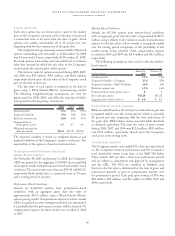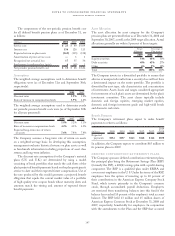American Express 2008 Annual Report Download - page 100
Download and view the complete annual report
Please find page 100 of the 2008 American Express annual report below. You can navigate through the pages in the report by either clicking on the pages listed below, or by using the keyword search tool below to find specific information within the annual report.
notes to consolidated financial statements
american express company
98
The following table summarizes the income effects of derivatives for the years ended December 31:
(Millions) 2008 2007 2006
Cash flow hedges, net of tax(a)
Ineffective net losses $ — $ (1) $ (1)
Gains on forecasted transactions no longer probable to occur $ — $ — $ 4
Reclassification of realized (losses) gains from other comprehensive loss $(161) $ 30 $ 158
Fair value hedges, net of tax(a)
Ineffective net losses $ 45 $ — $ (1)
Net investment hedges, net of tax:
Ineffective net gains $ 2 $ — $ —
Reclassification of loss from cumulative translation adjustment as a result of sales of foreign entities $ — $ (3) $(110)(b)
(a) There were no (losses) gains due to exclusion of any component of derivative instruments from the assessment of hedge effectiveness for 2008, 2007 and 2006.
(b) Represents the sale of Brazil and certain other dispositions.
cash flow hedges
A cash flow hedge is a derivative designated to hedge the
exposure of variable future cash flows attributable to a particular
risk of an existing recognized asset or liability, or a forecasted
transaction. The Company hedges existing long-term variable-
rate debt, the rollover of short-term borrowings and the
anticipated forecasted issuance of additional funding through
the use of derivative instruments, primarily interest rate swaps.
These derivative instruments effectively convert floating rate
debt to a fixed rate debt for the duration of the swap.
In the normal course of business, as derivatives mature, the
Company expects to reclassify $87 million of net pretax losses on
derivative instruments from accumulated other comprehensive
(loss) income to earnings during the next 12 months.
Currently, the longest period of time over which the
Company is hedging exposure to variability in future cash flows
for forecasted transactions is approximately one year, which is
related to certificate of deposits.
fair value hedges
A fair value hedge is a derivative designated to hedge the
exposure of future changes in the fair value of an asset or a
liability, or an identified portion thereof that is attributable to
a particular risk. The Company is exposed to interest rate risk
associated with its fixed-rate long-term debt. The Company
uses interest rate swaps to convert certain fixed-rate long-term
debt to floating rate at the time of issuance.
If the fair value hedge is fully effective, the gain or loss on
the hedging instrument would exactly offset the loss or gain on
the hedged item attributable to the hedged risk. Any difference
between the changes in the fair value of the derivatives and
the hedged item is referred to as hedge ineffectiveness. Hedge
ineffectiveness may be caused by differences between the
interest coupon and the benchmark rate, primarily due to credit
spreads at inception of the hedging relationship, which are not
economically reflected in the terms of the interest rate swap.
net investment hedges
A net investment hedge in a foreign operation is a derivative
used to hedge future changes in currency exposure of a net
investment in a foreign operation. The Company designates
foreign currency derivatives, primarily forward agreements, as
hedges of net investments in certain foreign operations. These
derivatives reduce exposure to changes in currency exchange
rates on the Company’s investments in non-U.S. subsidiaries.
derivatives not designated as hedges
The Company has derivatives that act as economic hedges
and that either do not qualify or are not designated for hedge
accounting treatment. Foreign currency transactions and non-
U.S. dollar cash flow exposures may from time to time be
partially or fully economically hedged through foreign currency
contracts, primarily forward contracts, foreign currency
options, and cross-currency swaps. These hedges generally
mature within one year. Foreign currency contracts involve the
purchase and sale of a designated currency at an agreed upon
rate for settlement on a specified date. The changes in the fair
value of the derivative instrument effectively offset the related
foreign exchange gains or losses on the underlying balance sheet
exposures. From time to time, the Company may enter into
interest rate swaps to specifically manage funding costs related
to its proprietary card business. The following table provides the
total fair value, excluding accruals, of these derivative product
assets and liabilities as of December 31:
(Millions) 2008 2007
Assets Liabilities Assets Liabilities
Foreign currency
transactions $127 $134 $31 $38
Interest rate swaps $ 9 $ 20 $29 $ 8
























